The GIGABYTE B360 Gaming 3 WIFI Review: A Cheaper Alternative at $120
by Joe Shields on July 11, 2018 9:45 AM ESTVisual Inspection
The GIGABYTE B360 Gaming 3 WIFI isn't expected to turn heads on looks at this price point, yet it is also not always expected to be shoved inside a closed case either. To that end, the motherboard uses a dark brown, almost black PCB with brown traces running throughout the board. The now familiar AORUS bird is stenciled in prominently around the audio and PCIe area of the board. The power delivery heatsinks are silver in color with a brushed aluminum finish while the chipset heatsink is a black and silver combo.
At a high level, we see typical features here from the 8-pin power lead and a few fan headers up top, four DRAM slots, and six SATA ports to dual M.2 slots along with a slot for the included Intel CNVi Wi-Fi. The top M.2 slot uses a fairly beefy cooler to keep the PCIe NVMe M.2 drives cool. All slots are in black with the primary full-length PCIe slot reinforced to help with heavy video cards. There is a plastic cover for the I/O area and in this case, does not extend down over the audio area as we have seen on other boards.
The B360 Gaming 3 WIFI does include RGB LED illumination. The LEDs are located under the PCH heatsink as well as several running along the bottom of the board lighting up the audio separation strip on the bottom left-hand corner. Along with the onboard lighting, there are a couple of RGB LED headers for additional lighting supporting standard 5050 RGB (RGBW) lighting with a power rating of up to 2A. Both the integrated and attached lights are controlled by the RGB Fusion software.
The board has a total of five 4-pin fan headers able to control the attached air mover through PWM and voltage methods. The two CPU headers and a system fan header are located up top flanking the heatsink on either side, with an additional system fan near the 24-pin ATX 12V connector. The last header (sysfan/pump) is located on the bottom left. There is not a mention if these headers are able to handle over the standard 1A output. All fans are controlled through the BIOS or through Easy Tune and the Smart Fan functionality. Also in view is the first M.2 slot that has the Thermal Guard heatsink on it.
Looking at the top half of the board with the heatsinks removed, we see seven phases for power delivery for the board. The Intersil 95866 4+3 Multiphase PWM regulator controller manages the power sent to the On-Semiconductor MOSFETs. In this case, the B360 Gaming 3 WIFI uses 4C10N and 4C06N 'FETs to help deliver stable power to the CPU. Power is supplied to the VRMs through a single 8-pin EPS 12V connector. We didn't see any throttling during testing while using an i7-8700K.
The closer view of the right side of the board shows the six SATA ports on the far left, the PCH heatsink, a Thunderbolt 3 5-pin header, a USB3.0 header, and a system fan header. Next to the 24-pin ATX 12V have RGB LED connections along with a voltage control jumper for the digital LED headers.
This picture shows the six SATA ports on the board as well as a view of the dummy boot LEDs. Note the top M.2 connector shares bandwidth with the SATA port 5 and the bottom M.2 connector shares with SATA port 3. When either is used in SATA mode, the corresponding SATA port will be unavailable. Also worth noting is the B360 chipset does not support RAID.
The bottom portion of the board holds is where we can see the Realtek ALC892 audio codec hidden under the EMI shields along with its Chemicon capacitors on the bottom left and the PCIe slots in the middle. The board includes three full-length slots with the top full-length slot being the only one CPU connected. The board does support Crossfire but not SLI due to the second slot only supporting a maximum of x4 mode. This slot also shares bandwidth with the two x1 slots. When these are populated, the second PCIe slot operates at x2 mode.
| AORUS B360 Gaming 3 WIFI CPU PCIe Layout | ||
| 16-Lane Single |
16-Lane Dual |
|
| PCIe 2 | @x16 | @x16 |
| PCIe 4 (chipset) | x4 | @x4 |
| SLI | - | No |
| Crossfire | - | Yes |
The back panel IO has a mix of USB 2.0 (4x ports), USB 3.0 (3x ports) and a USB 3.1 Type-A port which should be plenty for most users. As for video outputs, the B360 Gaming 3 WIFI offers DVI-D and HDMI outputs to use the integrated graphics. Last, is a six-plug audio stack, powered from the Realtek ALC892 codec.
In the Box
GIGABYTE Includes the following:
- Driver Disk / Installation Guide / Manual
- Back I/O Plate
- 2 x SATA cables
- Intel CNVi Wi-Fi module
- Antenna



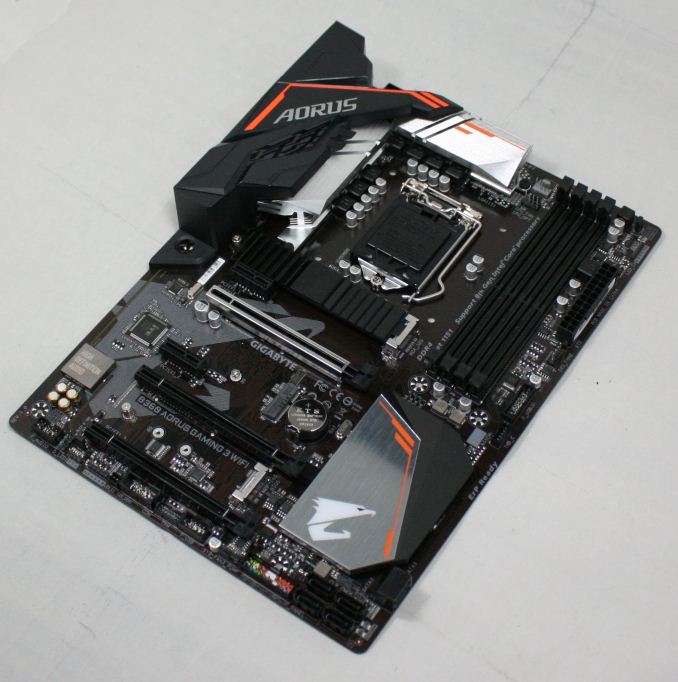
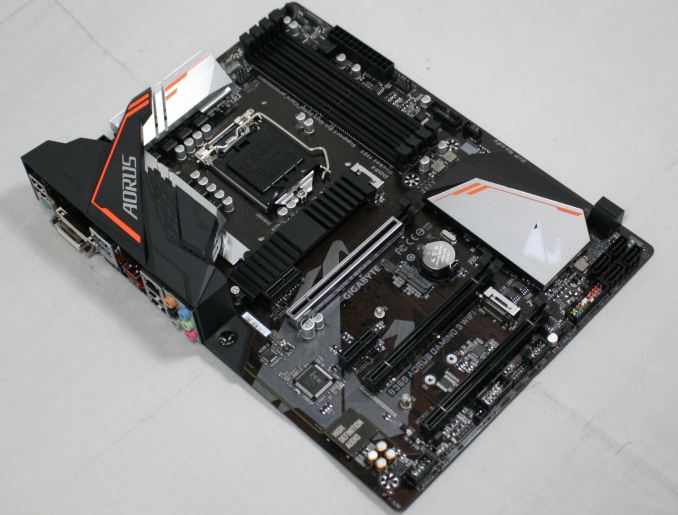
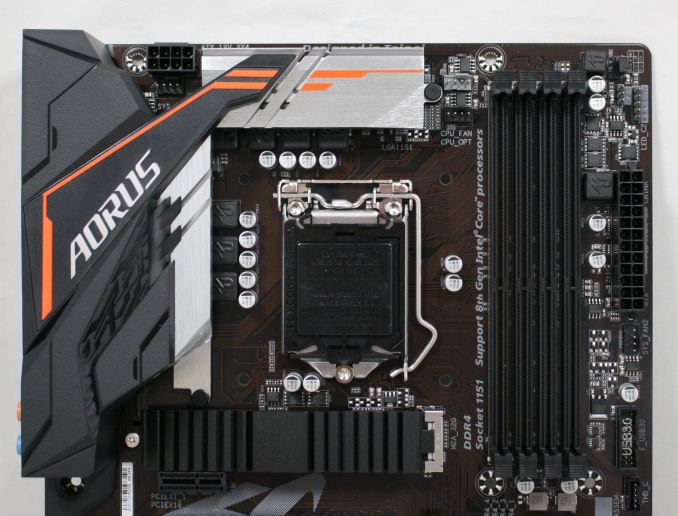
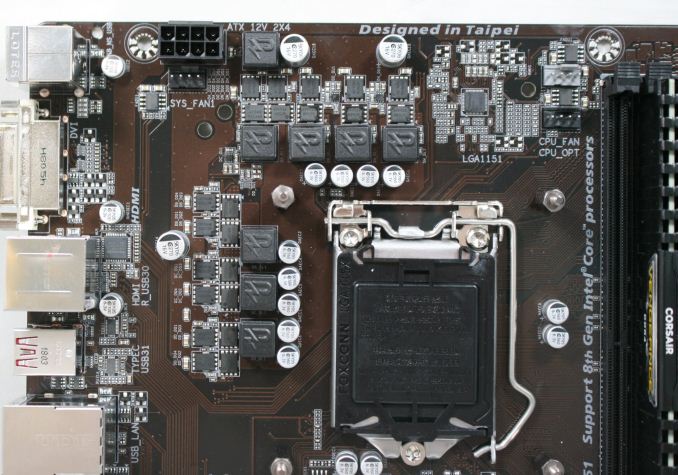
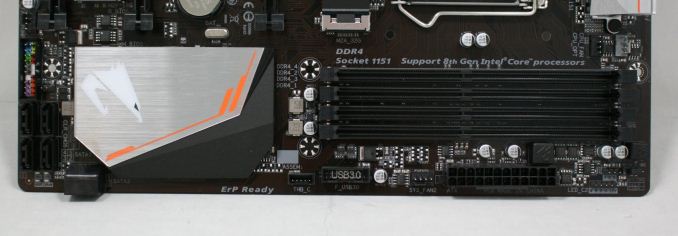
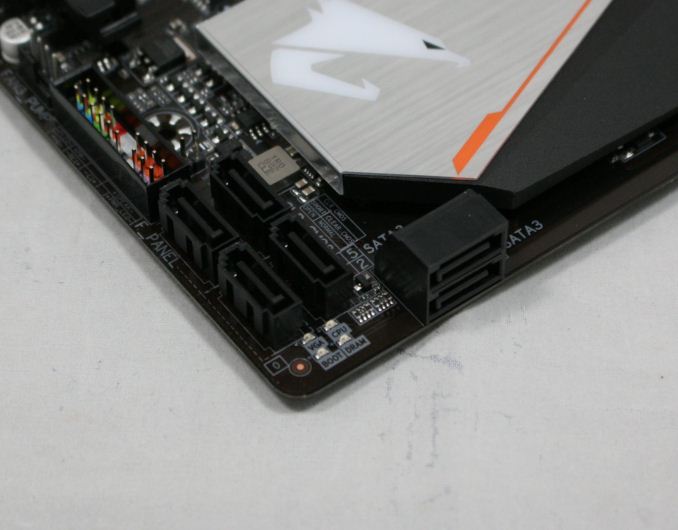
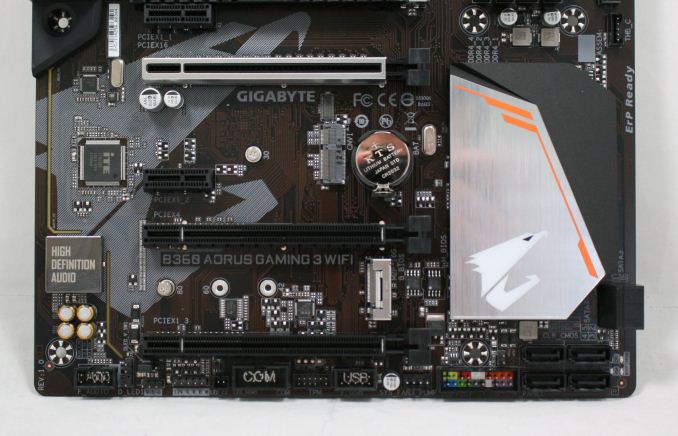
















18 Comments
View All Comments
drw28 - Wednesday, July 11, 2018 - link
can you review the gigabyte UD pro drives?the combination of phison s10 and toshiba's bics nand would be interesting to see.peevee - Wednesday, July 11, 2018 - link
There used to be you could get a decent ATX MB for the latest mainstream CPU for around $50. What happened? Is it Intel overpricing their chipsets?imaheadcase - Wednesday, July 11, 2018 - link
In what world did you visit to get that cheap..i think you are mistaken.DanNeely - Wednesday, July 11, 2018 - link
In aggressive sales perhaps. Otherwise, while I recall seeing an occasional $50 board; the reviews always indicated that there was something wrong with them. Either from a company known to only build garbage (eg PC Chips, ECS before they figured out how to make good products, or a few other companies who're dead and forgotten) or an occasional screwed up board from a mainstream brand. I remember getting an ASUS S939 board for maybe $60 years ago, when it crapped out and I looked at reviews I turned out that I wasn't alone, something like 50% 1/2 stars from people whose boards had died on them.The True Morbus - Thursday, July 12, 2018 - link
I think there used to a PERCEPTION that you could get a decent board for 50 bucks, but that's probably because most 150$ boards looked similar to most 50$ boards.You can still buy the 50$ boards if you want. They'll be the first thing to give out in the build, you can write that down. And no, it doesn't matter if they're from a famous brand, they'll likely give out even quicker if that's the case.
PeachNCream - Thursday, July 12, 2018 - link
The last $50 motherboard I purchased was a Gigabyte GA-F2A68HM-HD2 which was a FM2 socket mATX board. The SATA connectors all failed at the same time about three months after I bought it. There was a DVD drive on one and a 1TB WD hard drive on another when it gave up and stopped detecting devices. I tried a few other drives, shuffled ports around, got new cables, etc and the hard drive worked in an external case just fine (still is working in fact). It wasn't worth the trouble to go through customer support for RMA, but it was a bit annoying. That was the last time I wasted effort on a desktop of any sort and PC games for the most part as well. Glad to be done with that particular disaster after multiple decades of chasing system requirements. Cell phone gaming FTW!peevee - Thursday, July 12, 2018 - link
My last personal builds were in 2000 (on ASUS) and 2011 (ASRock). Never failed. Maybe they were 50-something.peevee - Thursday, July 12, 2018 - link
The latter is the Z68 board I still use. With then brand-new top-of-the-consumer-line i7-2600k.Still OCZ Vertex 3 256GB bought for $500 then, still works (although until they have fixed its firmware about a year later it had troubles). Now THAT one still alive is a surprise.
Galcobar - Wednesday, July 11, 2018 - link
Some copy editing might be in order. Aside from the raft of grammatical errors (e.g. worth vs worthy of), random commas and typos (e.g. B350, i7-8400), specifications are contradictory.For example, page 1: "... a total [of] four USB 2.0 ports, three USB 3.0 ports (one Type-C), and one USB 3.1 (10 Gbps) port (red Type-A)."
Page 2: "USB 2.0 (4x ports), USB 3.0 (3x ports) and a USB 3.1 Type-C port"
Also, when did Anandtech switch (back) to referring to USB 3.1 Gen 1 and Gen 2 as, respectively, USB 3.0 and 3.1? Five days ago it was the former.
Joe Shields - Wednesday, July 11, 2018 - link
The typo mentioned RE: USB was corrected. Thank you for catching that.As far as the 'switch'.... I know in my reviews, at least the past dozen or two, I have been referring to it in this manner consistently AFAIK. Prior to that I would use something like "USB 3.1 (speed here)" to clarify.